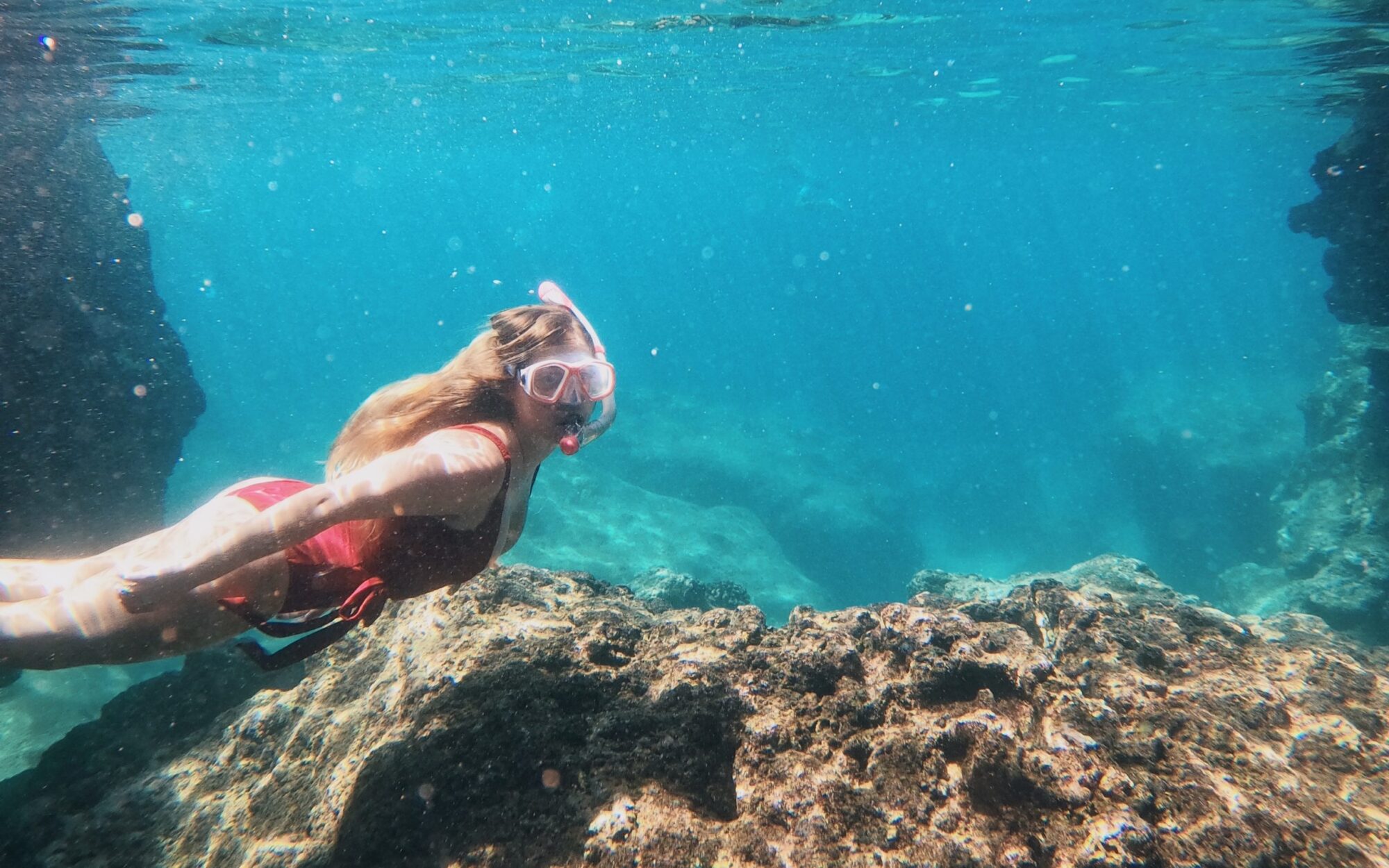Summer is quickly approaching, and in O’ahu, Hawai’i, that means snorkeling and diving season is nigh. Between the months of May and September, waters become calmer, clearer, and ideal for swimming with marine life and exploring the underwater world. We’ve compiled our top five free snorkeling destinations below, and ordered them from our personal most to least favorite.
Shark’s Cove
Complete with underwater caves, massive schools of fish, tide pools, and some pretty epic jump rocks, Shark’s Cove is a super popular snorkeling spot for good reason. This protected marine area is located on O’ahu’s North Shore and is one of our favorite places to spend an afternoon in the summertime. Shark’s Cove is best for intermediate snorkelers, yet there are ample protected places for beginners and children to explore as well. Click here for a video of a day spent at Shark’s Cove.
Logistics: Shark’s Cove is mostly inaccessible during winter months as waves can reach upwards of 20 feet in height. Parking is limited, so prepare to arrive early. While there are not any concessions on the beach, directly across the street you’ll find a food truck park that we could not recommend more. Despite its name, there are no resident sharks inhabiting this cove. Turtle’s Cove would be a much more appropriate name, if you ask us.

Kahe Point Beach Park aka Electric Beach
Electric Beach earned its namesake due to its location across the street from the Hawaiian Electric Plant. This power plant uses ocean water to cool its generators, and pumps the resulting heated water back into the ocean via huge pipes located a few hundred feet offshore. Because of the warmed waters surrounding the pipes, Kahe Point attracts a diverse array of sea creatures, including dozens of fish species, sea turtles, and even dolphins. Click here for our video of a day spent at Electric Beach.
Logistics: The current can be extremely strong here. Fins are necessary, and only very strong swimmers should visit this location. Also, the beach is extremely narrow, and only really serves as a place to ditch your shoes while you are out on the water. We recommend leaving any valuables that you have at home, and only leaving your shoes/towel on shore.
Waimea Bay
Waimea Bay is yet another of our favorite North Shore haunts that hosts massive schools of fish, underwater tunnels, and an epic jump rock. Like many other North Shore beaches, Waimea Bay turns from a local body surfing spot in the winter into a calm diving oasis in the summer. Click here for a video of a day spent at Waimea Bay.
Logistics: Parking is limited. Be prepared to either arrive early to secure a space in the lot or park on the road and hike down to the beach. While we’ve done this trek barefoot/in flipflops, we most definitely wouldn’t recommend it, so bring shoes with some tread. Bathrooms are available, however there are not any food stands, so prepare for your day here accordingly. This bay is also home to a pretty expansive, sandy beach, so spending a few hours here makes for a perfect family-friendly beach day for all ocean-lovers – not just snorkelers and divers.

Three Tables Beach
Right down the road from Shark’s Cove lies Three Tables Beach. This protected marine sanctuary got its name from the three distinct sections of flat reef that can be seen above the ocean’s surface during low tide. Waves here can be a bit choppy, and entering and exiting the water from the rocky shore can be a challenge, so we recommend this beach for intermediate/experienced snorkelers.
Logistics: Like Shark’s Cove, Three Tables is mostly inaccessible during winter months as waves can reach upwards of 20 feet in height. Parking is also limited, so prepare to arrive early or spend time driving around waiting for a spot to become available.
Hanauma Bay State Park
In Hawaiian, Hanauma translates to “curved bay,” and natives and royalty alike were known to have used this area for fishing and entertainment for thousands of years. Today, with approximately 1 million visitors per year, this state park and marine life conservation area is by far the most popular snorkeling destination on the island. It is also the most accessible, and suitable year round for swimmers of various skill-levels.
Logistics: While visiting this bay is free for children under 12, active military members, and local residents, there is a $12 fee for all other visitors, and a $3 cash only parking fee per vehicle. The park is open from 7am-4pm, and is closed Mondays and Tuesdays. Lockers and snorkeling gear are available to rent, and snacks are available for purchase. Reservations are required and can be made here.


Some final thoughts: When snorkeling on O’ahu, it is critically important to respect both the ocean and your personal abilities. Never turn your back to the waves, always follow all rules and warning signs in place, and heed the saying “if in doubt, don’t go out.”
Also, always be sure to wear reef-safe sunscreen, never walk on coral, and never attempt to touch, feed, or otherwise disturb any marine life. When it comes to viewing wildlife, see NOAA’s guidelines here. Also, just as you should when visiting any outdoor space, it is best to take a “Leave No Trace” approach when visiting the beach in order to reduce your impact – learn more about how to visit our beaches sustainably here.




